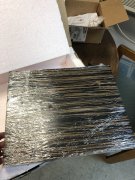derek92994
Veteran and General Yakker
- Joined
- May 1, 2013
- Messages
- 7,576
- Location
- Australia
- Tagline
- Those who enter the man cave will get WOPLed
AC motors are very accurate in speed, provided that the hertz from the supply is stable. I hear its difficult to change the speed of AC motors because it involves changing the hertz, requiring an expensive speed box. At least to my limited knowledge. Correct me if I'm wrong.
The Thorens TD 160 Super, 165 and Pioneer PL-31D tables I own are all AC motor and I had to resort to changing the size of the platter or motor pulley to slow them down, because they were all slightly fast. I'm told this was done to compensate in case the hertz coming from the power socket was slightly out. The increase in speed drove me nuts, as I am very pitch sensitive.
I can relate with having to remove the platter and manually move the belt onto the larger part of the pulley to change speeds, the Thorens tables are very stubborn if the belt is not 100%, they simply will not change speed if this is the case. Sometimes the belt will throw itself off if you try to start it from a dead stop at 45rpm speed, so a gentle turn of the platter will be required on startup.
The Thorens TD 160 Super, 165 and Pioneer PL-31D tables I own are all AC motor and I had to resort to changing the size of the platter or motor pulley to slow them down, because they were all slightly fast. I'm told this was done to compensate in case the hertz coming from the power socket was slightly out. The increase in speed drove me nuts, as I am very pitch sensitive.
I can relate with having to remove the platter and manually move the belt onto the larger part of the pulley to change speeds, the Thorens tables are very stubborn if the belt is not 100%, they simply will not change speed if this is the case. Sometimes the belt will throw itself off if you try to start it from a dead stop at 45rpm speed, so a gentle turn of the platter will be required on startup.


![IMG_4143[1].JPG IMG_4143[1].JPG](https://forums.phxaudiotape.com/data/attachments/57/57015-5df7619ba0aa9f671f8ccd941d68918c.jpg?hash=Xfdhm6Cqn2)
![IMG_4145[1].JPG IMG_4145[1].JPG](https://forums.phxaudiotape.com/data/attachments/57/57016-1b9aa932527952cbfb987934cd191241.jpg?hash=G5qpMlJ5Us)
![IMG_4147[1].JPG IMG_4147[1].JPG](https://forums.phxaudiotape.com/data/attachments/57/57017-dbeb8a1faaf602936421ba8417822eef.jpg?hash=2-uKH6r2Ap)
